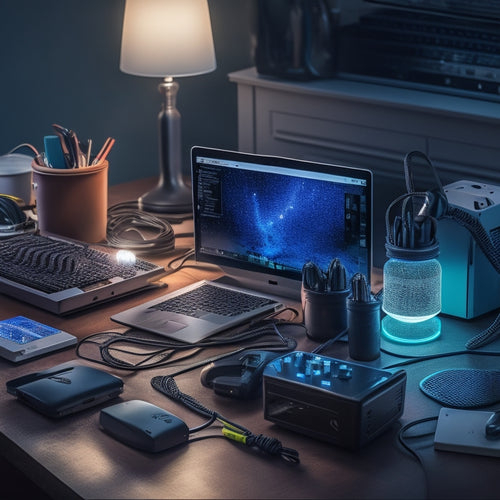
Optimize Home Energy: Power Management Storage Solutions
Share
You can efficiently manage your home's energy consumption and reduce your carbon footprint by leveraging advanced power management storage solutions. These solutions integrate smart grid technologies, renewable energy sources, and energy-efficient devices to optimize energy usage. Smart plugs and outlets provide real-time energy tracking, while load management and custom scenes help reduce peak demand and energy waste. Automated power control and demand response strategies can also be employed to minimize energy consumption during peak hours. By exploring these state-of-the-art solutions, you'll uncover a wealth of opportunities to maximize energy efficiency and sustainability in your home.
Key Takeaways
- Smart power management solutions integrate with smart grids, enabling real-time monitoring and control of energy usage for optimized efficiency.
- Energy storage solutions, like solar power storage and advanced battery technologies, capture excess energy for later use, reducing waste and utility bills.
- Automated power control and demand response strategies shift non-essential loads to off-peak hours, minimizing energy consumption during peak periods.
- Remote control and notifications through smart plugs and outlets provide users with real-time energy tracking and monitoring, promoting targeted efficiency efforts.
- Eco-friendly battery options and grid-independent systems ensure sustainability, recyclability, and energy independence, contributing to a cleaner energy transformation.
Smart Power Management Essentials
Implementing smart power management essentials in your home is crucial for optimizing energy efficiency and reducing your carbon footprint.
By integrating your home with the smart grid, you'll be able to monitor and control your energy usage in real-time. This allows you to implement demand response strategies, such as shifting non-essential loads to off-peak hours, reducing your energy consumption during peak periods.
With the rise of renewable energy sources, homeowners can now utilize clean energy and store excess power for later use, minimizing overall environmental impact.
Energy Efficiency With Smart Plugs
You can easily upgrade your home's energy efficiency with smart plugs that offer plug-and-play ease, allowing you to quickly get started with monitoring and controlling your devices' energy usage.
With real-time energy tracking, you'll be able to see exactly how much energy each device is consuming, helping you identify areas for improvement.
By implementing load management strategies, you can reduce peak demand and save on energy costs.
Additionally, optimizing your energy usage through smart plugs can also help you avoid peak charges, just like how EV charging stations can benefit from load management.
Plug and Play Ease
With smart plugs, energy efficiency becomes a breeze to achieve, as they allow you to control and monitor your appliances' energy usage remotely through an app. You can easily schedule on/off times, set energy budgets, and receive notifications when an appliance is consuming excessive power.
For instance, optimizing your solar panel array design array sizing is vital to guarantee maximum energy production. The user-friendly interface of smart plugs guarantees seamless integration with your devices, allowing you to effortlessly manage your energy usage.
You can also group devices together, creating custom scenes that cater to your lifestyle. This plug-and-play ease of use enables you to take control of your energy consumption, making it simple to optimize your home energy and reduce your environmental footprint.
Real-Time Energy Tracking
Smart plugs take energy management to the next level by providing real-time energy tracking, giving you a precise illustration of your energy consumption.
You'll have access to real-time analytics, enabling you to monitor and understand your energy usage patterns. With this information, you can identify areas of inefficiency and make informed decisions to optimize your energy consumption.
By considering the installation costs of commercial EV charging stations, which can range from $500 to $50,000+ installation costs overview, you can better understand the importance of energy efficiency.
You'll be able to see which devices are using the most energy, and when. This level of transparency enables you to take control of your energy usage, reducing waste and saving you money on your utility bills.
Automated Power Control
By the minute, smart plugs can automatically turn devices on and off, ensuring that energy is only consumed when necessary. You can optimize your home energy with automated scheduling, setting specific times for devices to turn on or off.
This feature is especially useful for devices that consume standby power, eliminating unnecessary energy waste. With the integration of energy storage systems, you can further optimize your energy usage and reduce reliance on the grid.
Additionally, leveraging fast charging capabilities can also minimize downtime and enhance overall energy efficiency. With smart plugs, you can also participate in demand response programs, which allow you to adjust your energy usage in response to changes in grid demand.
This not only helps the environment but also provides you with incentives and rewards. By taking control of your energy usage, you'll enjoy greater freedom and savings on your energy bills.
Solar Power Storage Solutions
You're likely considering solar power storage solutions to optimize your home energy setup.
When it comes to storing excess energy generated by your solar panels, you'll want to investigate energy storage systems that efficiently capture and store power for later use.
Your options will include battery backup systems, grid tie inverters, and other innovative solutions that guarantee a reliable and efficient energy supply.
Energy Storage Systems
Energy independence relies on the ability to employ and store excess energy generated by solar power systems, making energy storage systems a crucial component of any home energy optimization strategy.
As you consider energy storage solutions, you'll want to investigate options that integrate seamlessly with your hybrid energy systems. Here are three key areas to focus on:
-
Advanced Battery Technologies: Capitalize on innovations like flow battery innovations to optimize your energy storage capacity.
-
Renewable Energy Integration: Confirm your energy storage system is designed to work in harmony with your solar power system, enabling efficient renewable energy integration.
-
Energy Storage Policies: Stay up-to-date on community energy solutions, electric vehicle charging regulations, and demand response strategies to maximize the benefits of your energy storage system.
Battery Backup Options
Your solar power system generates excess energy during the day, but what happens when the sun sets or during a power outage?
You'll need a reliable battery backup option to guarantee a steady supply of power. Lithium batteries offer high energy density and a long lifespan, making them an attractive choice.
Lead acid batteries, on the other hand, are more affordable but require more maintenance.
Solar batteries, designed specifically for off-grid systems, provide a seamless shift during power outages.
When selecting a battery, consider installation costs, backup capacity, and charging efficiency.
With the right battery backup option, you'll enjoy uninterrupted power and achieve true energy independence.
Grid Tie Inverters
As the solar power system generates excess energy during the day, grid tie inverters play an essential role in utilizing this power and feeding it back into the grid.
You'll benefit from grid integration benefits, such as offsetting your energy consumption and reducing your utility bills.
Here's how grid tie inverters work:
-
Monitoring and control: The inverter technology advancements enable real-time monitoring and control of your solar power system, ensuring peak energy production and grid synchronization.
-
Synchronization and grid feed: The inverter synchronizes the solar power output with the grid frequency and feeds the excess energy back into the grid.
-
Safety and protection: The grid tie inverter includes built-in safety features to protect you, your solar power system, and the grid from any potential hazards.
Optimizing Home Energy Consumption
Within your home, a multitude of devices, appliances, and systems consume energy, contributing to your overall energy expenditure.
To optimize your energy consumption, it's crucial to develop awareness of your energy habits and consumption patterns. Conducting an energy audit helps identify areas of inefficiency, allowing you to make behavioral changes and implement efficiency tips.
By understanding your power demand and adjusting your lifestyle, you can reduce your energy usage during peak hours. This requires resource management and a willingness to make adjustments.
Smart Outlet Technology Advantages
The advent of smart outlet technology has revolutionized the way you manage your home's energy consumption.
With smart outlets, you can control and monitor your appliances' energy usage remotely, giving you the freedom to optimize your energy consumption from anywhere. This technology integrates seamlessly with your smart home system, allowing you to automate your energy management.
Some key advantages of smart outlet technology include:
-
Remote accessibility: Control your appliances from anywhere using your smartphone or tablet.
-
Schedule-based energy management: Set schedules for your appliances to turn on and off, ensuring you only use energy when needed.
-
Real-time energy monitoring: Receive real-time updates on your energy consumption, helping you identify areas for improvement.
Energy Monitoring and Control
While you're away, smart outlets continuously track your appliance's energy consumption, providing you with a detailed breakdown of your energy usage patterns. This data enables you to identify areas of inefficiency and make informed decisions to optimize your energy usage.
Conducting efficiency audits and analyzing consumption patterns helps you pinpoint opportunities for behavioral changes, reducing your energy footprint. With real-time monitoring, you can participate in demand response programs, shaving peak energy usage and reducing strain on the grid.
Additionally, load balancing and renewable integration capabilities allow for seamless home automation. By leveraging usage forecasting and energy monitoring, you can take control of your energy consumption, making your home a hub of efficiency and sustainability.
Sustainable Energy Storage Options
Most homeowners can considerably reduce their reliance on non-renewable energy sources by incorporating sustainable energy storage options into their home energy optimization strategy.
This change enables you to utilize renewable resources, like solar and wind power, and store excess energy for later use. By doing so, you'll decrease your carbon footprint and contribute to a cleaner energy transformation.
Here are three sustainable energy storage options to evaluate:
-
Eco-friendly batteries: Look for batteries made from recyclable materials and designed with sustainability in mind. This will guarantee that even when they reach the end of their lifespan, they can be recycled and reused.
-
Grid-independent systems: These systems allow you to store energy generated from your renewable resources, providing you with energy independence and reducing your reliance on the grid.
-
Climate-resilient solutions: Invest in energy storage solutions that are designed to withstand extreme weather conditions, assuring your home remains powered even during outages.
Frequently Asked Questions
Can I Use Smart Plugs With Traditional Incandescent Bulbs?
You can use smart plugs with traditional incandescent bulbs, but it's not the most efficient option; consider switching to smart lighting solutions for ideal energy efficiency, and enjoy the freedom to control and monitor your energy usage remotely.
Do Solar Power Storage Solutions Require Regular Maintenance?
As you ride off into the sunset of energy independence, you'll find solar power storage solutions require regular battery maintenance and solar upkeep to guarantee peak performance, just like keeping your trusty steed in top condition.
Are Energy Storage Systems Compatible With Existing Electrical Infrastructure?
You'll find that energy storage systems are designed to be compatible with your existing electrical infrastructure, but you may face challenges integrating them, such as voltage and frequency mismatches, requiring careful planning to overcome these electrical infrastructure challenges.
Can Smart Outlets Be Controlled Remotely Using Voice Assistants?
You can control smart outlets remotely using voice assistants like Alexa or Google Home, thanks to seamless voice assistant integration, allowing you to turn devices on/off and schedule tasks via remote device management, giving you freedom and convenience.
Are There Energy Storage Solutions Suitable for Small Apartments?
You'll find energy storage solutions suitable for small apartments, considering battery capacity and apartment size. Look for compact, high-density batteries like lithium-ion or lead-acid, offering 2-10 kWh capacity, perfect for small spaces, giving you freedom from energy constraints.
Related Posts
-

Why Choose Cool Roofs in Scorching Climates?
You opt for cool roofs in scorching climates because they enable you to reclaim control over your energy consumption ...
-

3 Sun-Powered Automated Shades for Energy-Savvy Homes
You're looking to change your home into an energy-savvy haven, and sun-powered automated shades are an essential step...
-

What Do Power Strips Do for Standby Energy?
You're likely aware that your devices, such as TVs and computers, continue to draw power even when turned off, a phen...


